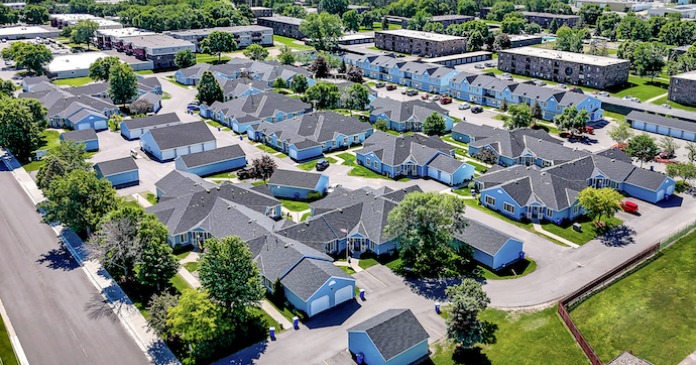CoStar reported that its value-weighted index of multifamily property prices increased only 1.0 percent year-over-year in December 2022. The index was down 1.4 percent month-over-month, the fifth monthly decline in a row.
The value-weighted index of non-multifamily commercial property fell by 1.6 percent year-over-year in December. This index rose 1.5 percent month-over-month. The other commercial property types tracked by CoStar are office, retail, industrial and hospitality.
For more information on the CoStar Commercial Repeat Sales Indexes (CCRSI’s), please see the section at the bottom of this report.
Comparing property types
The first chart, below, shows the history of the value-weighted CCRSI’s since January 2012 for multifamily property and for all other commercial property considered as a single asset class. It also shows trend lines for the growth in the two CCRSI’s based on their growth in the period from January 2012 to January 2020. The indexes are normalized so that their values in December 2000 are set to 100.
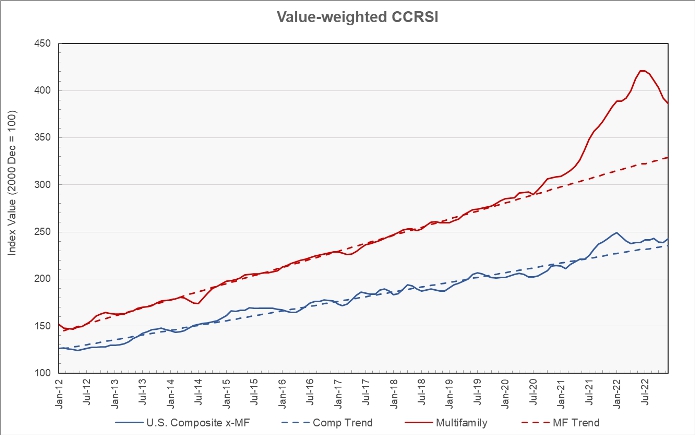
The chart shows that the two indexes closely tracked their trend lines until 2021. After rising well above their trends during the pandemic, the indexes have been moving back toward the trend lines. In December the multifamily CCRSI was 17.5 percent above the trend line, down from the peak deviation of 30.6 percent reached in July. The CCRSI for non-multifamily commercial property was 2.9 percent above the trend in December. Its peak variation from trend was +9.8 percent in January 2022.
The second chart shows the year-over-year change in the value-weighted multifamily property price index and that for all other commercial property types since January 2012. It also shows the average rates of annual price growth for the two property classes over that time.
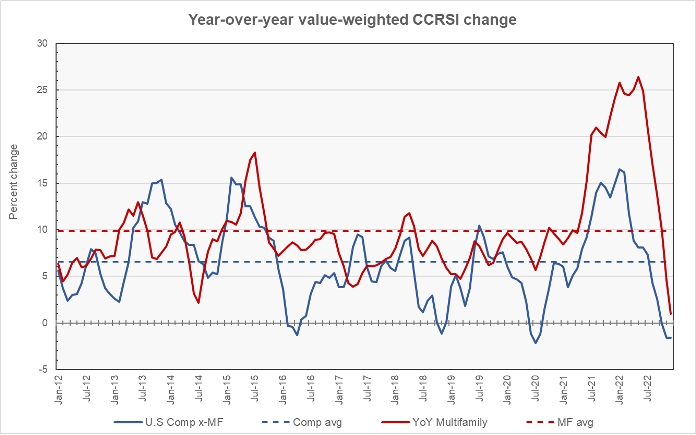
The chart shows that the year-over-year rate of increase in the prices of both classes of property has been falling sharply recently. The rate of year-over-year increase in multifamily property prices is now well below its recent average and is on the verge of turning negative. The rate of year-over-year increase in other commercial property prices has been negative for the last three months.
The annual increase in multifamily property prices has been 9.9 percent while that of other commercial property prices has been 6.6 percent. For comparison, MSCI Real Capital Analytics reports that the average annual increase in multifamily property prices has been 11.0 percent while that of other commercial property has been 8.3 percent.
Tracking the regions
CoStar’s quarterly reports include information on the changes in the equal-weighted CCRSI by region. The history since Q1 2012 of these regional indexes for multifamily property is shown in the next chart, below. The chart shows that, between 2012 and 2016, multifamily property prices in the four regions grew at similar rates. However, the growth in the price indexes by region diverged after that point.
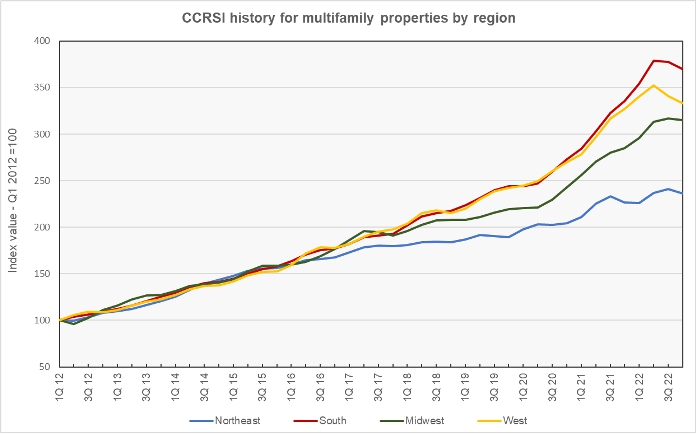
Prices in the Northeast region have risen at the slowest rate since 2012 of any of the four regions. However, prices in this region are still up the most of any region of the country since CoStar started tracking them in 2001. Overall, the South region has seen the greatest price appreciation since 2012.
The final chart shows the history of the regional year-over-year multifamily property price changes by quarter since 2016. The chart shows that the rate of increase in the CCRSI has been falling from its pandemic highs in all four regions of the country. Perhaps surprisingly, in Q4 2022 the Midwest region had the highest rate of year-over-year growth in its price index.
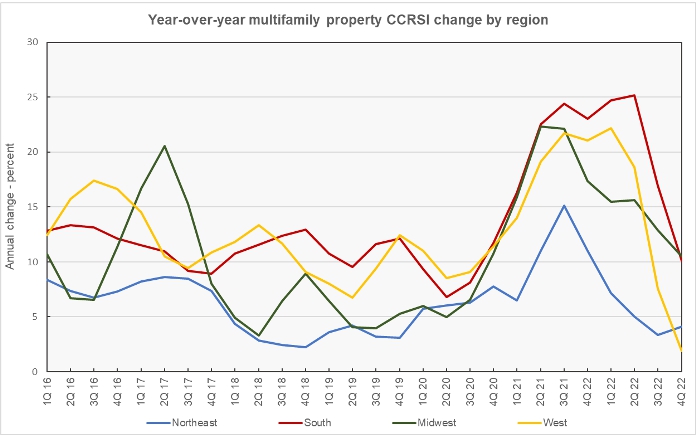
Based on CoStar’s equal-weighted quarterly indexes and comparing to year-earlier levels, prices in Q4 2022 were up by 10.5 percent in the Midwest, 10.1 percent in the South, 4.1 percent in the Northeast and 1.9 percent in the West.
Transaction volumes up
An issue with monthly transaction volume reporting is that CoStar usually identifies additional transactions to tabulate over the next few months after the initial report for a given month is released and these transactions can have a large influence on the reported results. For example, the latest report identified an additional 163 transactions for November not reported last month. This is an increase of 13.4 percent in November transactions.
Keeping in mind that initial reports may overstate declines in activity and understate rises in activity, the preliminary number of transactions reported for December was up 22.9 percent from the preliminary level of the month before. However, it was up only 8.4 percent month-over-month from the revised level of the month before.
The preliminary dollar volume of transactions was reported to fall 2.5 percent from the revised level of the month before. However, it was up 5.0 percent from the preliminary level reported last month.
The full report discusses all commercial property types. While the CoStar report provides information on transaction volumes, it does not break out multifamily transactions. The latest CoStar report can be found here.
CCRSI defined
The CoStar report focuses on a relative measure of property prices called the CoStar Commercial Repeat Sales Index (CCRSI). The index is computed based on the resale of properties whose earlier sales prices and sales dates are known. The index represents the relative change in the price of property over time rather than its absolute price. CoStar identified 1,495 repeat sale pairs in December for all property types. These sales pairs were used to calculate the results quoted here.
CoStar computes CCRSI’s for a variety of property groupings, combining them by cost, region, property type or other factors. The value-weighted index is more heavily influenced by transactions of expensive properties than is CoStar’s equal-weighted index. The value-weighted index is the focus of this report because it is an index whose value is reported monthly and for which CoStar breaks out multifamily property as a separate category.










